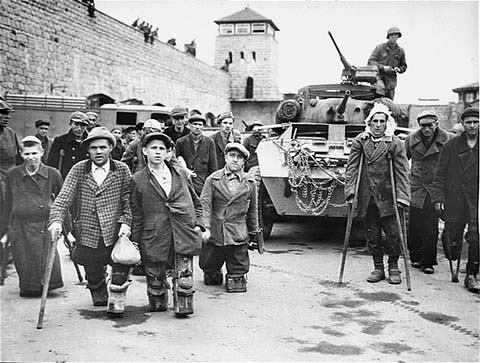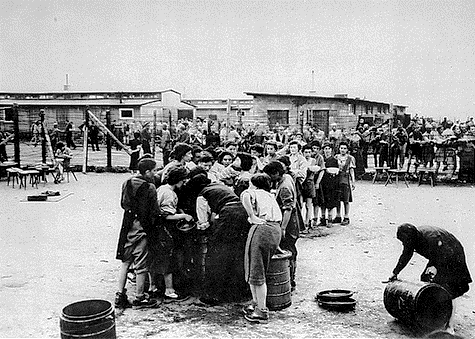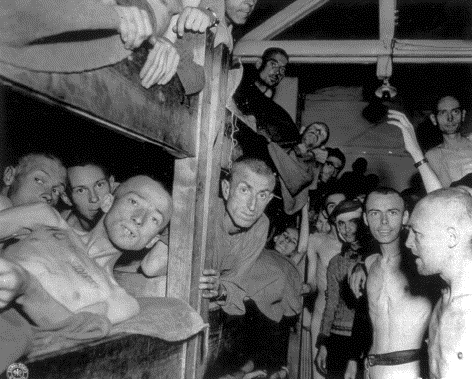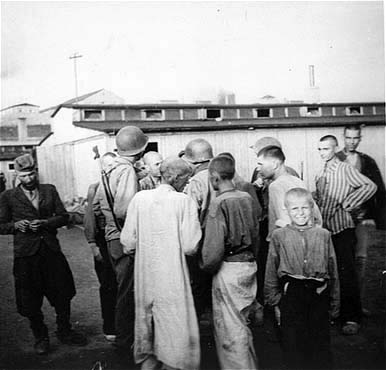Mauthausen Concentration Camp Survivors On May 5, 1945, the day of the official liberation of the Mauthausen Concentration Camp by American troops, there were approximately 60,000 survivors in the main camp and all the sub-camps, according to Christian Bernadac, one of the prisoners in the camp. This was approximately half as many prisoners as had been registered during the period that the camp was in existence from August 1938 to May 1945. In the photo above, crippled survivors of the main camp at Mauthausen pose in front of an M8 Greyhound armored car of the US Army 41st Calvary Reconnaissance Squadron of the 11th Armored Division of the US Third Army. The crippled prisoners had had their feet amputated after suffering severe frostbite. This photo was a reenactment, taken on May 6, 1945, of the liberation the day before. Note the warm coats they are wearing; Mauthausen is located in the mountains of Austria where it can still be cold in the first week of May.  On February 19, 1945, Count Folke-Bernadotte of Sweden met with Reichsführer-SS Heinrich Himmler, the man responsible for all the Nazi concentration camps, and got his authorization to transfer all the Scandinavian prisoners to the Neuengamme concentration camp which would then be administered by the Red Cross. On March 16, 1945, a Swedish doctor named Hans Arnoldson and a nurse, Sister Birgit, came to Mauthausen to take 54 Scandinavian prisoners out of the Mauthausen camp. They were the first survivors to be rescued from Mauthausen. A few days later, Arnoldson and Sister Birgit returned to rescue 16 Norwegian women who had recently been sent to Mauthausen from the women's camp at Ravensbrück. A Red Cross representative arrived again in the camp on April 21, 1945 and several convoys of French, Belgian and Dutch prisoners were taken out of the camp. Commandant Franz Ziereis cooperated with the Red Cross and entertained them royally at dinner, while at the same time he continued to order the gassing of prisoners at Mauthausen until April 28, 1945, according to the survivors. Martin Gilbert wrote in his book entitled "Holocaust," that there was a total of 110,000 survivors in the whole Mauthausen complex, including thousands who had just arrived in the last week of the war after being evacuated from other camps and had not been registered. In 1947, the Soviet Union released the records from Mauthausen, which showed that there were 122,767 prisoners registered in the main camp and all the sub-camps. This did not include prisoners who arrived from other camps in the last two weeks before Mauthausen was liberated. One of the liberators of Mauthausen was a First Lieutenant in the 65th Infantry Division of the US Third Army. Identified only as Col. Edmund M., he stated the following in an interview, which is quoted in the book "Witness, Voices from the Holocaust": "The thing that impressed I think all of us almost immediately was the horrible physical condition of most of the inmates whom we saw. Some of them undoubtedly looked in fairly good health, but these were in the minority. Most of them were in very, very bad shape. Some of them actually looked almost like living skeletons. I took a look at some, and I would estimate the average weight probably might have been eighty, ninety pounds or so. "Many inmates, including some whom I met later, were in very bad situations physically from diseases. Typhus, for example. I would estimate that the majority of the inmates within this camp had typhus. In addition to typhus there was diarrhea, dysentery, typhoid, pneumonia, diphtheria - you have, any - almost any disease mentionable."  According to Martin Gilbert, one of the survivors of the main camp was Sidney Fahn from Bratislava who had been brought to Mauthausen from Auschwitz-Birkenau. Fahn weighed only 80 pounds and was too weak to stagger from his hospital bed to greet the American liberators who handed out chocolate and other rich food to the survivors. Gilbert wrote: These emaciated men and women, here, as in other camps, were no longer used to such food, nor could their digestive systems cope with it. It was too rich, too fatty, too filling, and it killed, in the first hectic day of liberation, as surely as the bullets and the rifle butts of the day before. One of the prisoners at Mauthausen, who survived Auschwitz, only to die on May 5, 1945, the day of liberation, was Peter van Pels, the boy who hid in the annex with Anne Frank in Amsterdam. No one knows the cause of his death.  Only a few of the survivors were still in good health. Note the child shown in the photograph above, who is in remarkably good condition. The Communist prisoners in the camp were well organized, so they were able to take care of the children and make sure that they were well fed. One of the Jewish survivors of the Mauthausen main camp was Mike Jacobs (Mendel Jakubowicz) from Konin, Poland, who emigrated to Dallas, TX in 1951 at the age of 26. He founded the Dallas Memorial Center for Holocaust Studies which features exhibits from Mauthausen including his own striped cap which he says is "soaked with blood and sweat where I used to be beaten..." While he was a prisoner at Mauthausen, Mike says that he made a fake watch from parts stolen from the Messerschmitt jet airplane factory there. He told Theo Richmond, the author of the book "Konin, One Man's Quest for a Vanished Jewish Community" that this fake watch helped him to survive because he felt less dehumanized with a watch on his arm, just like the SS guards wore, although he had to keep it hidden under his sleeve. He was 19 and a half when the Americans arrived to save him. Jack Sittsamer, an Orthodox Jew, was 20 years old and weighed 72 pounds when he was liberated by American troops at Mauthausen. He had survived six concentration camps after being arrested by the Nazis in March 1942 in his home town of Mielec, Poland and marched 7 miles to an airplane hangar. His father was shot on the march because he couldn't keep up. Jack was separated from his family and sent to the first of six concentration camps. His whole family was killed in the Holocaust, including his parents, two brothers and two sisters. After he was liberated, he lived in a refugee camp in Eggenfelden, Germany until the United Jewish Federation helped him to moved to America in July 1949. Jack Sittsamer died in October, 2008. One of the most noteworthy survivors of Mauthausen was Leopold Figl, a politician who was the co-founder of the Austrian People's Party (ÖVP) in 1945. He was the Federal Chancellor of Austria from 1945 to 1953 and the Federal Minister for Foreign Affairs from 1953 to 1959. In 1959 he became the First President of the Nationalrat (1st chamber of the Austrian Parliament). From 1962 to 1965 he was the Governor of Lower Austria. Another well known survivor of Mauthausen is Leon Zelman, a journalist who was born in 1928. He was the co-founder in 1978 of the Jewish Welcome Service in Vienna which helps Jews to return to Austria after they were forced to leave in 1938 by the Nazis. Simon Wiesenthal, an Austrian Jew born in 1908, is perhaps the most well-known survivor of Mauthausen. He arrived at Mauthausen in February 1945, after being evacuated from Auschwitz-Birkenau. Wiesenthal is one of the few survivors of Mauthausen who claims that there was no gas chamber there. He worked for the US War Crimes Office from 1945 to 1947 and founded the Jewish Documentation Centre in Linz in 1947. He made his home in Vienna in 1961 and worked tirelessly in hunting down Nazi war criminals until his death. The Simon Wiesenthal Center in Los Angeles is named after him. According to the story that he told reporters on May 11, 2009, Edward Mosberg was one of the survivors of Mauthausen, who "cannot forget certain images: A Nazi soldier ripping a baby from his mother's arms and smashing the baby's head against a wall; another soldier shooting through a rucksack to kill a hidden child." As a prisoner at Mauthausen, Mosberg had been "forced to carry heavy stones on his back up and down 186 steps all day." Mosberg said: "If you stopped for a moment, they either shot you or they pushed you off the cliff to your death." Not only was Mosberg forced to carry stones up the 186 steps all day, he also had to carry the stones back down the steps to the quarry. Other prisoners at Mauthausen worked in the Messerschmitt ME262 fighter plane factories that were built inside the quarry in 1943 after the work of taking stones out of the quarry had stopped. The prisoners in the punishment company had to carry one load of heavy stones up the 186 steps each day. The photo below shows the "Stairs of Death" at Mauthausen. A Soviet soldier stands as an honor guard after the camp was turned into a Memorial Site by the Communist Soviet Union.  Mosberg was among six Holocaust survivors who met Pope Benedict XVI during his visit to the Yad Vashem Hall of Remembrance in Jerusalem on May 11, 2009. Born in 1926, Mosberg was 13 in 1939 when his family was put into the Krakow Ghetto, which was shown in the early scenes of the movie Schindler's List. Mosberg told reporters that his "father was soon killed and one by one, his grandparents were taken to the gas chambers." When the Krakow ghetto was liquidated on March 13, 1943, Mosberg's remaining family was sent to the Plaszow camp, where Oskar Schindler saved more than 1,000 Jews by putting their names on a list to be sent to his new factory in what is now the Czech Republic. Mosberg and his family were not on the list. They were sent instead to Auschwitz where his mother was killed in the gas chamber. His two sisters were transferred from Auschwitz to the Stutthof camp near Gdansk. The night before the camp was liberated, according to Mosberg, his sisters were among the 7,000 young women who were shot by the Nazis and thrown into the Baltic sea. Mosberg told reporters that the Nazis
had made one last attempt to kill the group of men that he was
working with at Mauthausen. According to Mosberg, the Nazis told
the men that the Americans were coming and that they wanted to
save them from the soldiers, so the Nazi guards rounded up the
prisoners and put them into a cave that had been rigged with
dynamite. Mosberg said that it was a miracle that the dynamite
did not go off, and he was saved by the Americans who liberated
Mauthausen on May 5, 1945. Bert Schapelhouman - Dutch SurvivorHomeThis page was last updated on June 18, 2009 |